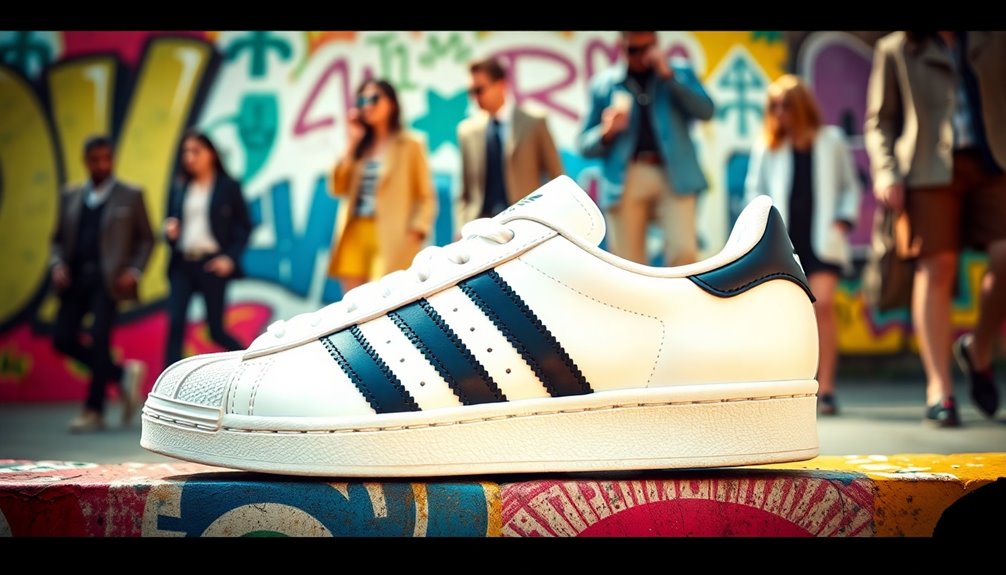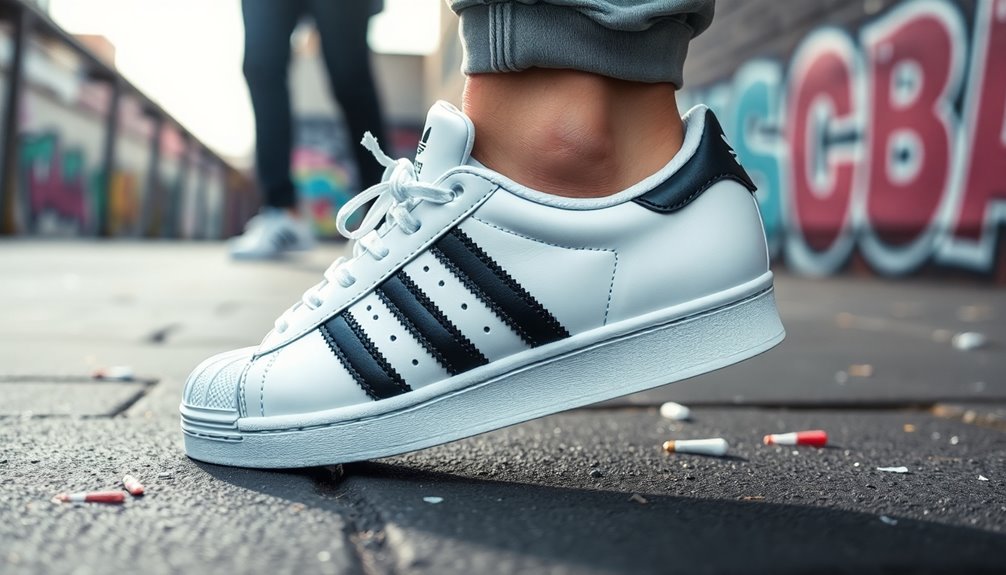The Adidas Superstar became the world’s favorite original by blending style and performance seamlessly. With its launch in 1969, it quickly captured the attention of 75% of NBA players, making it a sports necessity. Its transition into streetwear, bolstered by cultural icons like Run-DMC, transformed the sneaker into a symbol of fashion and self-expression. Its innovative design and collaborations have kept it fresh through decades. Discover how this sneaker continues to shape trends today.
Key Takeaways
- The Adidas Superstar transformed from a sports shoe to a cultural icon through strategic endorsements and collaborations, especially in music and fashion.
- Its innovative rubber shell toe provided comfort and durability, appealing to both athletes and style-conscious consumers.
- The sneaker’s association with hip-hop, particularly through Run-DMC, solidified its status as a symbol of streetwear culture.
- Consistent design evolution and fresh colorways kept the Superstar relevant, attracting new generations while maintaining classic appeal.
- Effective marketing strategies and brand ambassador partnerships reinforced its credibility and connection with sneaker enthusiasts globally.

The Adidas Superstar isn’t just a sneaker; it’s a cultural icon that’s shaped both sports and fashion since its debut in 1969. Originally launched as a basketball shoe, it quickly gained traction among professional players, thanks to its innovative rubber shell toe that enhanced durability. You can imagine how it took the NBA by storm, with stars like Kareem Abdul-Jabbar embracing it and helping it become the go-to choice for 75% of players within a few short years. By 1973, 70% of professional players had switched to Superstars, showcasing its rapid rise in popularity on the court.
The Adidas Superstar revolutionized sports and fashion since 1969, becoming a favorite among NBA legends and a cultural icon.
As the years rolled on, the Superstar transitioned from a sports necessity to a staple in sneaker culture. You’ve probably seen how it influenced fashion trends, becoming an essential piece for streetwear aficionados. Collaborations with designers and musicians kept it fresh and appealing, ensuring that each new generation could find something to love within its classic design. When Run-DMC wore it, they catapulted the Superstar into the realm of hip-hop culture, solidifying its status as more than just footwear—it became a statement.
Adidas capitalized on this momentum through effective marketing strategies, using brand ambassadors to foster a lasting connection with consumers. The endorsement deals with NBA players reinforced its credibility, while the influence of music groups continued to drive sales. You may have noticed that despite recent fluctuations in the market, the Superstar remains a beloved choice for many, showing that its appeal transcends mere trends.
The design of the Superstar has evolved too, featuring improved materials and advanced cushioning technology that provide comfort without sacrificing style. Various colorways and collaborations have kept it current, allowing you to express your individuality while rocking this iconic sneaker.
Ultimately, the Adidas Superstar has secured its place not only in the world of sports but also in the broader fashion landscape, proving that it’s more than just a shoe—it’s a timeless emblem of culture and style.
Frequently Asked Questions
What Year Was the Adidas Superstar First Released?
The Adidas Superstar first hit the market in 1970. You’ll find it was initially designed as a low-top basketball shoe, quickly gaining traction among players.
By the mid-70s, over 80% of basketball athletes were sporting them on the court. Their unique rubber shell toe and leather upper provided the durability and performance players needed.
As you explore its history, you’ll see how it evolved beyond sports into a cultural icon.
Who Designed the Adidas Superstar?
Did you know that the Adidas Superstar was first released in 1969? It was designed by Chris Severn and Horst Dassler at Adidas France.
Their innovative approach introduced the iconic rubber shell toe, which set it apart from other basketball shoes. You’ll appreciate how the design incorporated comfort features like a padded tongue and an oversized heel counter.
Over time, it evolved into a cultural icon, transcending its original purpose on the court.
What Materials Are Used in the Adidas Superstar?
The Adidas Superstar uses a mix of high-quality materials. You’ll find full-grain leather for durability, along with textiles for comfort.
The iconic rubber shell toe adds protection and style, while the herringbone-pattern rubber cupsole gives you excellent traction.
In some sustainable versions, recycled materials like ocean plastic and polyester are incorporated.
Breathable mesh lining enhances airflow, keeping your feet comfortable during wear.
Each component works together to create a timeless sneaker.
Are Adidas Superstars Unisex?
Did you know that over 30 million pairs of Adidas Superstars have been sold worldwide?
You’ll find that Superstars are indeed unisex, designed to appeal to everyone. Their classic shell-toe and versatile style make them suitable for both men and women.
With a wide range of sizes and colors, you can easily find a pair that fits your unique style, ensuring you’re part of a global fashion movement that transcends gender.
How Do I Clean My Adidas Superstars?
To clean your Adidas Superstars, start by removing the laces and soaking them in warm, soapy water.
Use a soft bristle brush to dust off dirt from the uppers, applying a leather cleaner if they’re leather.
For the outsole, scrub with a hard bristle brush and rinse thoroughly.
Let everything air dry away from sunlight, and store them in a cool, dry place.
Regular maintenance keeps them looking fresh!
Conclusion
In just over 50 years, the Adidas Superstar has sold over 30 million pairs worldwide, a testament to its undeniable appeal. Picture this: if you lined up all those sneakers, they’d stretch around the Earth more than once! This timeless icon has transcended trends and generations, becoming a staple in both sports and fashion. It’s clear that the Superstar isn’t just a shoe; it’s a cultural phenomenon that continues to unite people around the globe.









